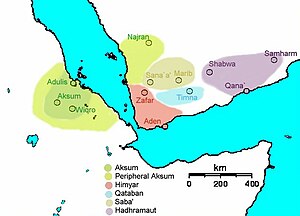Not to be confused with
Sabians, adherents to one of a group of related religions.

Sabaeans (khaki) in the 3rd century CE.
The Sabaeans or Sabeans (Arabic: السبأيون as-Saba’iyūn) were an ancient people speaking an Old South Arabian language who lived in what is today Yemen, in the south west of the Arabian Peninsula.[1]
Some scholars suggest a link between the Sabaeans and the Biblical land of Sheba, and would dismiss any link or confusion with the Sabians.[1]
History

Sabaean inscription addressed to the sun-god
Almaqah, mentioning five South
Arabian gods, two reigning sovereigns and two governors, 7th century BC
The ancient Sabaean Kingdom established power in the early 1st millennium BC. In the 1st century BC it was conquered by the Himyarites, but after the disintegration of the first Himyarite empire of the Kings of Saba' and Dhu-Raydan, the Middle Sabaean Kingdom reappeared in the early 2nd century. It was finally conquered by the Himyarites in the late 3rd century. Its capital was Ma'rib. The kingdom was located along the strip of desert called Sayhad by medieval Arab geographers, which is now named Ramlat al-Sab`atayn.
The Sabaean people were South Arabian people. Each of these had regional kingdoms in ancient Yemen, with the Minaeans in the north along the Red sea, the Sabeans on the south western tip, stretching from the highlands to the sea, the Qatabanians to the east of them and the Hadramites east of them.
The Sabaeans, like the other Yemenite kingdoms of the same period, were involved in the extremely lucrative spice trade, especially frankincense and myrrh.[2]
They left behind many inscriptions in the monumental Musnad (Old South Arabian) alphabet, as well as numerous documents in the cursive Zabur script.
In the Res Gestae Divi Augusti, Augustus claims that:
By my command and under my auspices two armies were led at about the same time into Ethiopia and into Arabia, which is called the Blessed [?]. Great forces of each enemy people were slain in battle and several towns captured. In Ethiopia the advance reached the town of Nabata, which is close to Meroe; in Arabia the army penetrated as far as the territory of the Sabaeans and the town of Mariba.[3]
The Sabaeans are referenced in the Book of Job for slaughtering the livestock and servants of the eponymous character.[4]
See also
Notes
References
- Bafaqīh, M. ‛A., L'unification du Yémen antique. La lutte entre Saba’, Himyar et le Hadramawt de Ier au IIIème siècle de l'ère chrétienne. Paris, 1990 (Bibliothèque de Raydan, 1).
- Andrey Korotayev. Ancient Yemen. Oxford: Oxford University Press, 1995. ISBN 0-19-922237-1 [2].
- Andrey Korotayev. Pre-Islamic Yemen. Wiesbaden: Harrassowitz Verlag, 1996. ISBN 3-447-03679-6.
- Ryckmans, J., Müller, W. W., and ‛Abdallah, Yu., Textes du Yémen Antique inscrits sur bois. Louvain-la-Neuve, 1994 (Publications de l'Institut Orientaliste de Louvain, 43).
- Info Please
- Article at Encyclopædia Britannica
External links



No comments:
Post a Comment